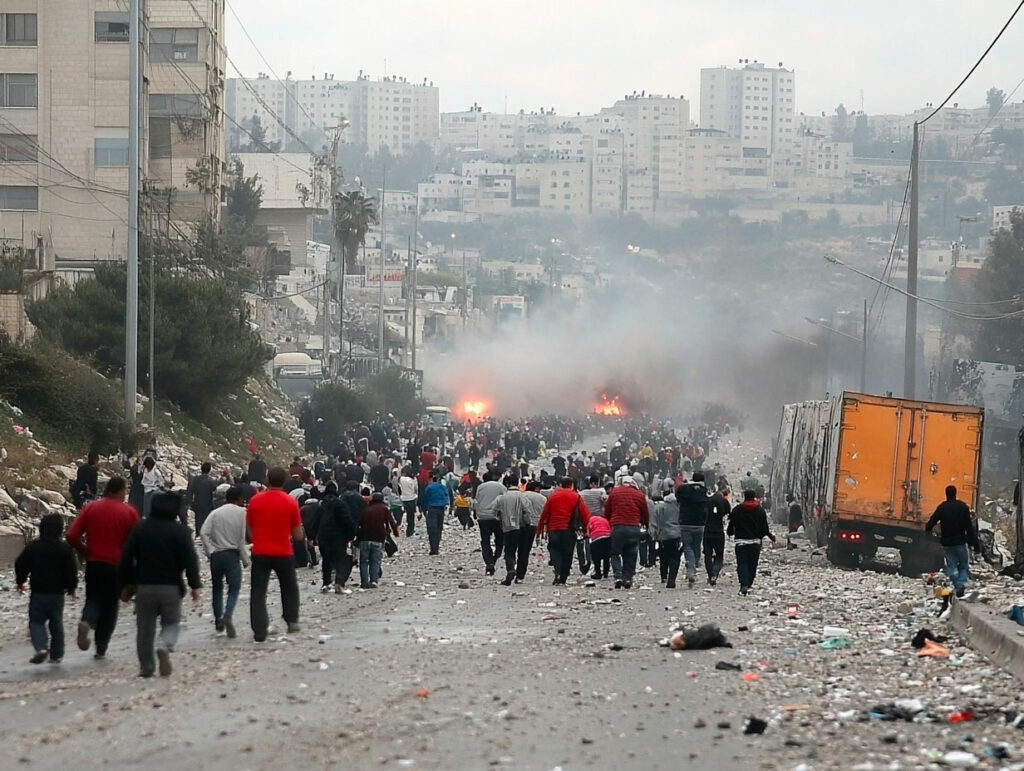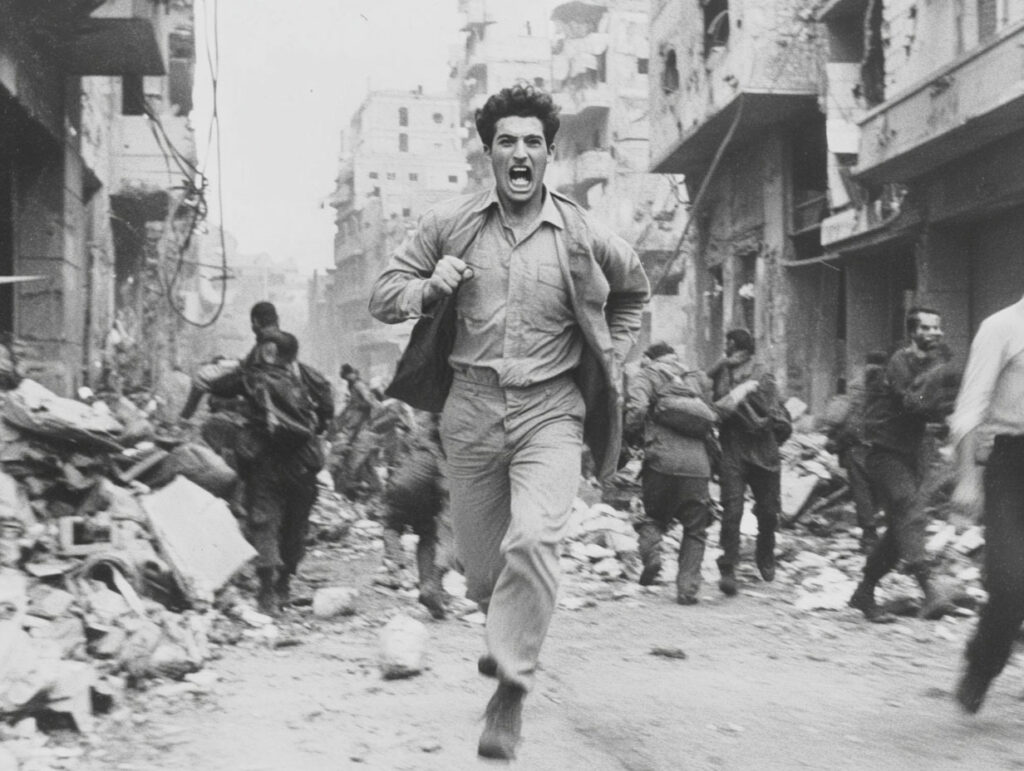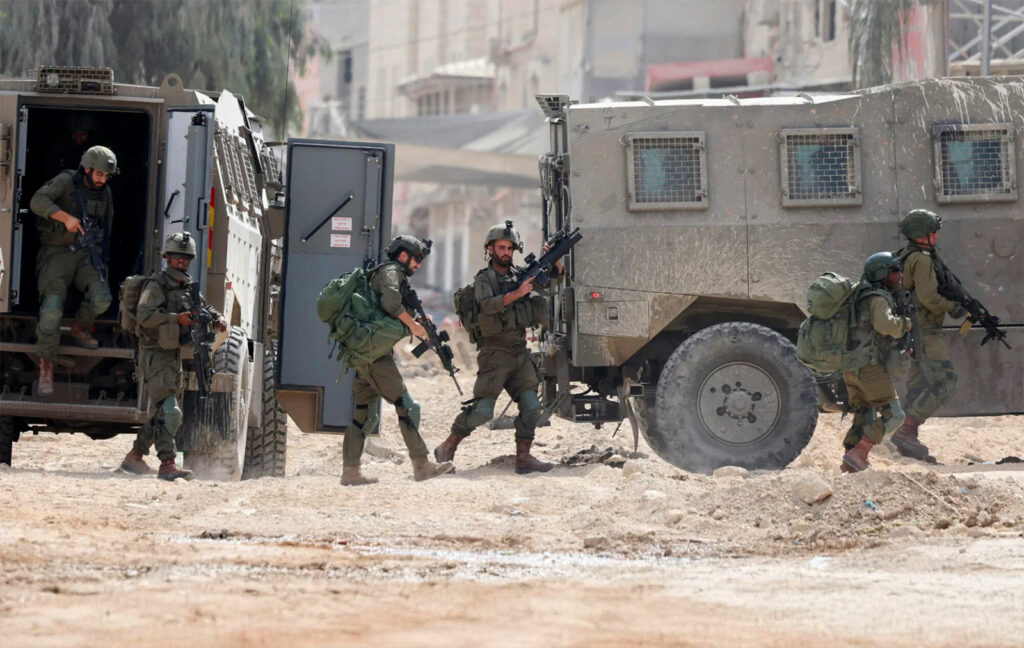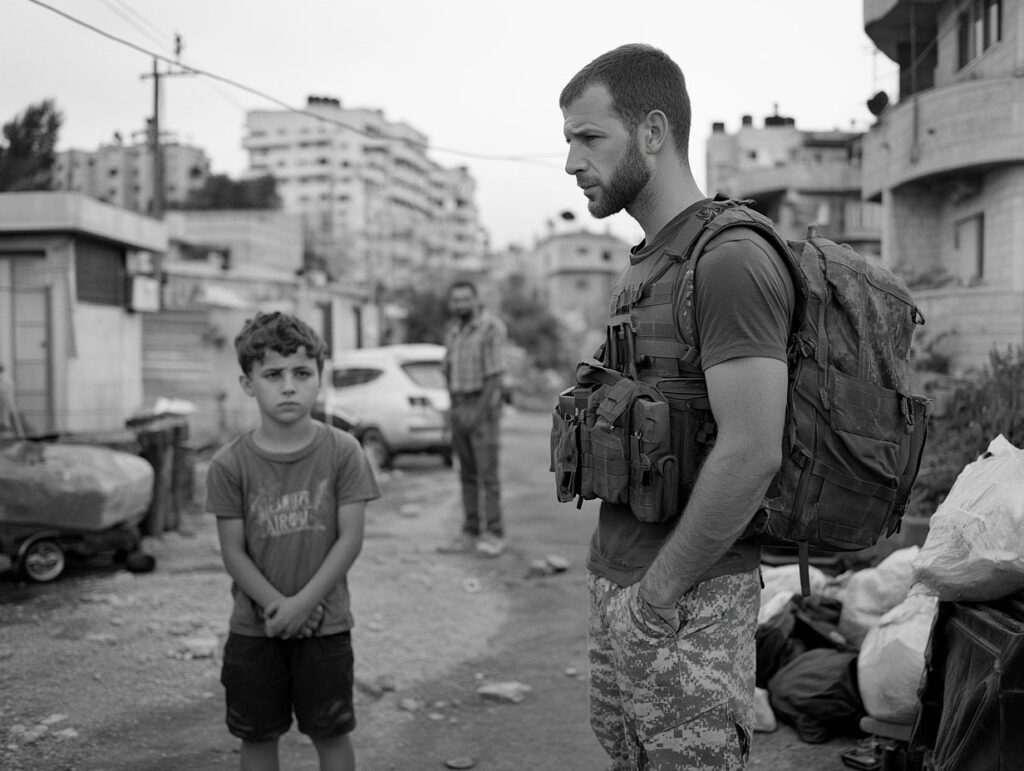An in-depth exploration of the Second Intifada (2000–2005), examining its causes, key figures, major events, and lasting impacts.
The Second Intifada, also known as the Al-Aqsa Intifada, erupted in late September 2000 following Israeli opposition leader Ariel Sharon’s visit to the Al-Aqsa Mosque compound, a site sacred to both Muslims and Jews. The visit was perceived by Palestinians as a provocation, igniting widespread protests that escalated into a prolonged conflict. Over five years, the uprising resulted in significant casualties on both sides, with more than 4,000 Palestinians and over 1,000 Israelis killed. The violence included suicide bombings, Israeli military incursions, and the construction of a separation barrier. Key figures included Palestinian leader Yasser Arafat and Israeli Prime Minister Ariel Sharon. The conflict concluded in February 2005 with a ceasefire agreement between Sharon and Arafat’s successor, Mahmoud Abbas, at the Sharm El Sheikh Summit. The Second Intifada had profound political, social, and economic consequences, reshaping the Israeli-Palestinian landscape and influencing future peace efforts.

What Were the Reasons for the Second Intifada (2000–2005)
The Second Intifada was fueled by a combination of political frustrations, failed peace negotiations, and immediate provocations. A significant catalyst was the collapse of the Camp David Summit in July 2000, where Israeli Prime Minister Ehud Barak and Palestinian Authority President Yasser Arafat failed to reach a final agreement on critical issues such as borders, the status of Jerusalem, and the right of return for Palestinian refugees. The inability to achieve a lasting peace deal led to widespread disillusionment among Palestinians.
The immediate trigger occurred on September 28, 2000, when Ariel Sharon, then the leader of the Israeli opposition, visited the Al-Aqsa Mosque compound in Jerusalem, accompanied by a large security detail. Palestinians viewed this visit as a deliberate provocation, leading to mass protests that were met with force by Israeli security forces. The resulting clashes quickly escalated into a broader uprising.
Underlying these events were longstanding grievances. Palestinians were frustrated by the ongoing Israeli occupation of the West Bank and Gaza Strip, the expansion of Israeli settlements, and restrictions on movement. The perceived failure of the Oslo Accords to deliver tangible improvements in daily life further eroded trust in the peace process.
Additionally, economic hardships played a role. High unemployment rates and poverty in Palestinian territories contributed to widespread dissatisfaction. The combination of political stagnation, economic despair, and perceived injustices created a volatile environment ripe for uprising.
The Second Intifada was the result of accumulated frustrations over failed peace efforts, immediate provocations, and deep-seated grievances related to occupation, settlements, and economic conditions.
Who Was Involved in the Second Intifada (2000–2005)
The Second Intifada involved a range of actors from both the Palestinian and Israeli sides, each playing distinct roles in the conflict.
Palestinian Actors:
- Palestinian Authority (PA): Led by Yasser Arafat, the PA was the official governing body in parts of the West Bank and Gaza Strip. While the PA initially sought to manage the uprising, its control weakened as violence escalated.
- Fatah: Arafat’s political faction, Fatah, had armed wings that participated in the uprising. Some members were involved in organizing attacks against Israeli targets.
- Hamas: An Islamist militant group, Hamas played a significant role by carrying out suicide bombings and other attacks. Its influence grew during the Intifada, challenging the PA’s authority.
- Islamic Jihad: Another militant group, Islamic Jihad conducted numerous attacks, including suicide bombings, contributing to the cycle of violence.
Israeli Actors:
- Israeli Government: Initially led by Prime Minister Ehud Barak and later by Ariel Sharon, the government responded to the uprising with military operations aimed at suppressing violence and targeting militant infrastructure.
- Israel Defense Forces (IDF): The IDF conducted extensive military operations in Palestinian territories, including incursions into cities and refugee camps, aiming to dismantle militant networks.
- Israeli Security Agencies: Agencies like Shin Bet were involved in intelligence gathering and targeted operations against suspected militants.
International Actors:
- United States: The U.S. played a mediating role, attempting to broker ceasefires and peace agreements, though with limited success during this period.
- European Union: The EU provided humanitarian aid and supported diplomatic efforts to resolve the conflict.
- United Nations: The UN monitored the situation, provided assistance to affected populations, and called for an end to violence.
In essence, the Second Intifada was a multifaceted conflict involving various Palestinian factions, the Israeli state and military apparatus, and international actors attempting to mediate and provide aid amidst the turmoil.

The Leaders of the Second Intifada (2000–2005)
Yasser Arafat (Palestinian Authority President): As the leader of the Palestinian Authority and the Fatah movement, Arafat was a central figure during the Second Intifada. While he publicly condemned attacks on civilians, Israel accused him of supporting militant activities behind the scenes. His leadership faced challenges as his authority weakened, and he became increasingly isolated, especially after being confined to his Ramallah compound by Israeli forces in 2002. Arafat’s death in November 2004 marked a significant turning point in Palestinian politics.
Ariel Sharon (Israeli Prime Minister): Sharon became Prime Minister in March 2001, succeeding Ehud Barak. Known for his hardline stance, Sharon authorized extensive military operations in response to Palestinian attacks, including Operation Defensive Shield in 2002. His policies aimed to enhance Israeli security but also led to significant Palestinian casualties and infrastructure damage. Despite his tough approach, Sharon later initiated the unilateral disengagement from Gaza in 2005, withdrawing Israeli settlers and military presence.
Ehud Barak (Israeli Prime Minister until March 2001): Barak was in office at the onset of the Second Intifada. His tenure was marked by the failed Camp David Summit, which contributed to the outbreak of violence. Barak’s inability to secure a peace agreement and the subsequent escalation of conflict led to his political downfall.
Mahmoud Abbas (Palestinian Authority President from 2005): Following Arafat’s death, Abbas was elected President of the Palestinian Authority in January 2005. He advocated for non-violent resistance and sought to revive peace negotiations. Abbas played a key role in the ceasefire agreement reached at the Sharm El Sheikh Summit in February 2005, which effectively ended the Second Intifada.
These leaders’ actions and policies significantly influenced the course of the Second Intifada, shaping both the conflict’s dynamics and the prospects for peace in its aftermath.
Was There a Decisive Moment?
A decisive moment in the Second Intifada came in March 2002, when a sharp escalation in Palestinian attacks and Israeli military responses fundamentally shifted the conflict. The month saw the highest number of Israeli casualties in a single month, with over 130 Israelis killed, many in suicide bombings. The most lethal attack was on March 27, 2002, during the Passover holiday. A Hamas suicide bomber entered the Park Hotel in Netanya, killing 30 civilians and injuring 140. This event triggered a major shift in Israeli strategy.
In response, Israel launched Operation Defensive Shield on March 29, 2002. It was the largest Israeli military operation in the West Bank since the 1967 Six-Day War. The Israel Defense Forces (IDF) conducted coordinated incursions into major Palestinian cities, including Ramallah, Nablus, Bethlehem, Jenin, Tulkarem, and Qalqilya. The stated goal was to dismantle what the Israeli government referred to as terrorist infrastructure.
In Jenin, the most intense urban combat took place. Israeli forces faced fierce resistance from militants using improvised explosive devices, snipers, and booby traps. The battle lasted several days and resulted in the deaths of 23 Israeli soldiers and an estimated 52 Palestinians, though the exact number is disputed. The UN later reported that most Palestinian casualties were combatants, but human rights organizations questioned the proportionality of the Israeli assault.
Operation Defensive Shield marked a shift in Israeli military doctrine. It moved from reactive measures to a systematic occupation of Palestinian urban centers. The operation also included the siege of Yasser Arafat’s compound in Ramallah, which effectively isolated the Palestinian leader and reduced his political influence.
This moment redefined the conflict. It led to a decrease in large-scale suicide bombings in Israel and signaled a more aggressive military posture. The events of March and April 2002, particularly Operation Defensive Shield, acted as a turning point in Israeli policy, placing security above negotiation and deeply affecting future diplomatic efforts.

Major battles of the Second Intifada (2000–2005)
The Second Intifada was characterized by urban warfare, military raids, and asymmetric confrontations between the Israeli military and Palestinian militants. Several major battles and operations defined the conflict’s intensity.
The Battle of Jenin (April 2002)
One of the most intense battles occurred in the Jenin refugee camp between April 1 and April 11, 2002, during Operation Defensive Shield. The IDF entered Jenin with infantry, engineering units, and armored vehicles. Palestinian militants, including members of Islamic Jihad, Fatah, and Hamas, had fortified the camp with booby-trapped homes, snipers, and ambushes. Israeli forces faced heavy resistance and relied on house-to-house searches rather than aerial bombardments to reduce civilian casualties. 23 Israeli soldiers were killed and approximately 52 Palestinians died, most of them identified as combatants. The camp was largely destroyed, sparking international criticism and allegations of excessive force.
The Battle of Nablus (April 2002)
Simultaneously, intense fighting took place in Nablus, particularly in the Kasbah (Old City). Israeli troops encountered strong resistance, and clearing operations lasted over two weeks. Over 70 Palestinians were killed. The IDF used bulldozers and armored personnel carriers to dismantle barricades and neutralize militant positions. The dense urban terrain complicated operations and led to high levels of destruction.
The Siege of Bethlehem and the Church of the Nativity (April–May 2002)
Another key episode unfolded in Bethlehem, where dozens of armed Palestinians took refuge in the Church of the Nativity, a major Christian religious site, along with monks and civilians. The siege began on April 2, 2002, and lasted 39 days. The Israeli army surrounded the church, leading to a prolonged standoff. After intense negotiations, 13 militants were deported to Cyprus and later to various EU countries, and another 26 were sent to the Gaza Strip. The incident strained Israel’s relations with the international community due to the symbolic and religious significance of the site.
Operation Days of Penitence (September–October 2004)
In response to Qassam rocket fire from the northern Gaza Strip, particularly from Beit Hanoun and Jabalia, the IDF launched Operation Days of Penitence from September 29 to October 16, 2004. The goal was to destroy rocket-launching infrastructure and neutralize militant cells. Israeli tanks and infantry entered densely populated areas, supported by air strikes. The operation resulted in the deaths of over 100 Palestinians, including civilians, and widespread damage to infrastructure. Five Israeli soldiers were also killed.
Other Operations
Smaller but frequent incursions occurred in Tulkarem, Hebron, and the Gaza Strip, aimed at arresting suspects and dismantling explosives labs. These operations followed a pattern: targeted raids, brief occupations, and withdrawals. Palestinian factions responded with ambushes, roadside bombs, and rocket attacks.
These battles showcased the intensity of the conflict and its urban nature. The use of non-state actors, asymmetric tactics, and the targeting of civilian areas made the Second Intifada fundamentally different from previous wars. Both sides paid a heavy human and material cost.
Was there a turning point?
The turning point in the Second Intifada came between late 2004 and early 2005, triggered by a series of developments that changed the conflict’s dynamics. The first major event was the death of Yasser Arafat on November 11, 2004, in a French hospital. Arafat had been confined to his Ramallah compound for more than two years and was seen by Israel and the United States as a barrier to peace. His absence created a power vacuum but also opened space for new leadership and strategy.
Mahmoud Abbas was elected President of the Palestinian Authority in January 2005, running on a platform of diplomatic engagement and opposition to militarized resistance. He called for a cessation of armed conflict and initiated steps to consolidate Palestinian security forces under central control, aiming to curb the influence of factions like Hamas and Islamic Jihad.
On the Israeli side, Prime Minister Ariel Sharon had already begun to shift his strategy. Despite his previous hardline positions, Sharon announced a unilateral disengagement plan in December 2003. This plan, finalized in 2005, included the withdrawal of Israeli settlers and military units from the Gaza Strip and parts of the northern West Bank. The move was presented as a security measure rather than a political concession but signaled a departure from attempts to manage the occupation through force alone.
The Sharm El Sheikh Summit on February 8, 2005, hosted by Egypt, brought together Sharon, Abbas, Jordan’s King Abdullah II, and Egyptian President Hosni Mubarak. During the summit, both Israel and the Palestinian Authority declared a ceasefire, effectively marking the formal end of the Second Intifada. The violence subsided significantly afterward, though low-intensity conflict and political tensions remained.
This period marked a shift from high-intensity conflict to renewed, though limited, diplomatic engagement. The change in Palestinian leadership, combined with unilateral Israeli actions and regional pressure, created the conditions for a significant de-escalation.

Consequences of the Second Intifada (2000–2005)
The Second Intifada left long-lasting effects on both Palestinian and Israeli societies, the regional balance, and international diplomacy. The human cost was significant. Over 4,000 Palestinians were killed, including civilians and combatants, while more than 1,000 Israelis, mostly civilians, also lost their lives. The number of wounded on both sides reached tens of thousands. The psychological impact was widespread, with populations living under daily threat of violence, curfews, and instability.
Political Consequences
In Palestinian territories, the Intifada weakened the Palestinian Authority. It lost control over large parts of the West Bank and Gaza as Hamas and Islamic Jihad gained influence. The conflict deepened internal divisions, eventually leading to the Hamas-Fatah split in 2007. The PA’s loss of legitimacy made governance more difficult and undermined future peace negotiations.
For Israel, the Intifada accelerated the shift towards unilateral policies. The most tangible result was the construction of the Israeli West Bank Barrier, also known as the separation wall. This physical barrier, hundreds of kilometers long, was designed to prevent terrorist attacks but also redefined geographic realities on the ground. Israel also pursued a strategy of targeted assassinations and intensified security control, shaping its future counterterrorism approach.
Economic Consequences
The economic toll was steep. The Palestinian economy contracted sharply. GDP per capita dropped by nearly 40% between 2000 and 2002. Unemployment soared, with over 50% of the labor force out of work in some areas. Infrastructure damage in urban centers further crippled development.
On the Israeli side, tourism and foreign investment declined sharply during peak years of violence. Security expenses increased, as did internal political tensions over settlement policies and military operations.
Social and Diplomatic Consequences
Social trust between Israelis and Palestinians collapsed. Polls conducted after 2005 showed a steep decline in support for peace negotiations among both populations. Educational curricula and media on both sides increasingly reflected mutual fear and blame.
Diplomatically, the failure of the peace process during and after the Intifada damaged the Oslo framework, shifting international efforts toward unilateralism and containment rather than negotiated settlement. The U.S., EU, and regional actors struggled to mediate between increasingly fragmented Palestinian factions and a more security-focused Israeli government.
The Second Intifada reshaped the landscape of the Israeli-Palestinian conflict. It entrenched divisions, altered territorial dynamics, and redefined how both sides approach conflict resolution and long-term stability.
Back to the Wars section